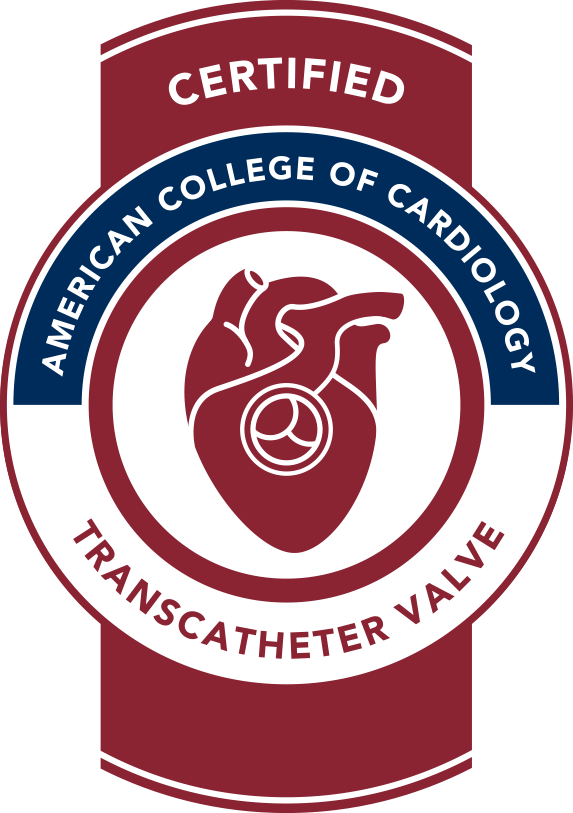TAVR Program for Aortic Valve Replacement
Aortic Valve Conditions
- Aquired valve disease - Refers to a heart valve problems can develop due to infection or injury
- Bicuspid aortic valve - a congenital condition when the aortic valve only has two flaps instead of three making it prone to early narrowing or leakage.
- Stenosis or stiffening of the aortic valve
Transcatheter Aortic Valve Replacement (TAVR)
If your aortic valve becomes so narrow that it causes problems, we can offer treatment without surgery. Our transcatheter aortic valve replacement (TAVR) safely and effectively relieves symptoms such as shortness of breath, chest pain, fainting and dizziness.
What is TAVR
- Transcatheter aortic valve replacement uses thin, flexible tubes called catheters to treat valve narrowing called aortic stenosis. Doctors place a tissue replacement valve inside the old valve.
- TAVR initially provided an alternative for people who needed valve replacement but were considered too risky for open-heart surgery. Now, the minimally invasive approach is the first option for most people, regardless of risk. A recent study found TAVR safer than open-heart surgery for aortic valve replacement.
- TAVR also provides a faster recovery than surgery. Rather than days in the hospital, most people spend less than 36 hours. And instead of weeks of healing, most people quickly return to normal life.
How is TAVR performed
Doctors perform TAVR in the cardiac catheterization lab. To start, the team chooses the best blood vessel for the procedure, then inserts a catheter and threads it toward your heart. The catheter carries your new valve.
Upon reaching your aortic valve, your doctor expands the replacement valve. The replacement valve pushes the existing valve’s leaflets out of the way and takes over.
TAVR Devices
Experienced Heart Team
At Billings Clinic, our heart team takes a rigorous approach to patient care.
- Our TAVR program is built on a foundation of multi-disciplinary experience.
- Billings Clinic has the highest volume TAVR program in the region, since starting the program in May 2016.
- Our procedural team consists of two heart surgeons, two interventional cardiologists and echo specialists.
- We have done over 12,000 open heart operations.
- Our interventional team performs more than 2,500 interventional heart procedures every year.
- Our physicians have been involved with transcatheter technology from the initial investigations in the United States with the latest valve models.
Together with our outstanding valve clinic coordinators, our colleagues from our cardiovascular division, anesthesiologists and radiologists, we are striving to offer the latest leading edge therapy to our patients and communities.
TAVR Approval by the FDA
In November 2011, the U.S. Food and Drug Administration (FDA) approved the SAPIEN Transcatheter Heart Valve for the treatment of patients with severe native aortic valve stenosis who have been:
- determined by a cardiac surgeon to be inoperable for open aortic valve replacement
- and in whom existing co-morbidities would not preclude the expected benefit from correction of the aortic stenosis
The Centers for Medicare and Medicaid Services (CMS) approved it for coverage in May 2012. In August 2016, the FDA approved the SAPIEN Transcatheter Valve for patients who are deemed at an intermediate risk for surgery.
How long have TAVR procedures been performed?
The first successful TAVR procedure was performed in France on April 16, 2002 by Dr. Alain Cribier. The TAVR has been commercially available in Europe since 2007 and in the United States since 2011.

We are the only valve center in the state certified by the American College of Cardiology.
Transcatheter aortic valve replacement (TAVR) is a procedure to replace an aortic valve that is narrowed and doesn’t open fully. This narrowing of the aortic valve, called stenosis, slows blood flow from the heart to the body. Billings Clinic was awarded Transcatheter Valve Certification from the American College of Cardiology (ACC) based on its demonstrated expertise and commitment in treating patients receiving transcatheter valve repair and replacement procedures, and on evaluation of the staff’s ability to meet standards for multidisciplinary teams, formalized training, shared decision-making and registry performance.
